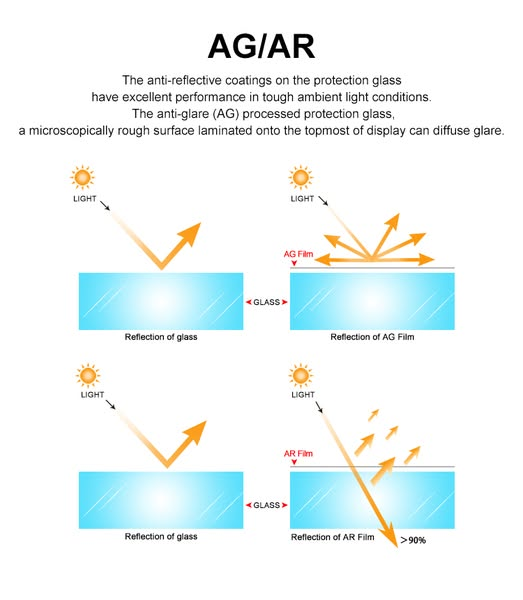In the world of modern lcd displays—whether on smartphones, tablets, e-readers, or industrial touch panels—glass surface treatments play a crucial role in enhancing visual clarity, usability, and durability. Among the most common treatments are AG (Anti-Glare), AR (Anti-Reflective), and AF (Anti-Fingerprint) coatings. But what exactly do these terms mean, and how do they impact your screen’s performance?

Anti-Glare (AG) treatment scatters incoming light to reduce surface reflections. It typically gives the screen a matte or satin finish.
l Minimizes glare from sunlight or indoor lighting
l Enhances readability in bright environments
l Reduces eye strain during long-term use
l Ideal for outdoor displays and public kiosks
Common Use Cases:
E-paper lcd displays, outdoor lcd monitors, automotive lcd displays, industrial lcd equipment

Anti-Reflective (AR) coatings reduce light reflection by using thin optical layers that cancel out glare through interference.
Benefits:
l Significantly reduces mirror-like reflections
l Increases contrast and color accuracy
l Improves screen brightness and clarity
l Allows better visibility under direct light
High-end lcd displays, camera lenses, medical monitors, digital signage
Anti-Fingerprint (AF) coatings use oleophobic materials that repel oils, making it harder for fingerprints and smudges to stick.
Benefits:
l Keeps screen surfaces cleaner
l Easier to wipe off smudges and dirt
l Enhances touch sensitivity and smoothness
l Improves hygiene and aesthetics
Common Use Cases:
Smartphones, tablets, touchscreen devices, shared-use terminals
Feature |
AG (Anti-Glare) |
AR (Anti-Reflective) |
AF (Anti-Fingerprint) |
Reduces surface glare |
✅ Yes |
✅ Yes |
❌ No |
Enhances touch feel |
❌ No |
❌ No |
✅ Yes |
Improves clarity |
✅ Moderate |
✅ High |
❌ No |
Resists fingerprints |
❌ No |
❌ No |
✅ Yes |
Surface appearance |
Matte |
Glossy/Clear |
Glossy/Clear |
Best for |
Outdoor use |
High-end displays |
Touchscreen hygiene |
Each surface treatment serves a specific purpose:
l Choose AG if you need readability under strong light and reduced eye strain.
l Choose AR if you want maximum clarity and color accuracy with minimal reflection.
l Choose AF if you want to keep your screen clean and smudge-free.
In many cases, manufacturers combine AG + AF or AR + AF to provide multi-functional protection and user-friendly surfaces. Understanding these treatments helps you make informed choices for displays in both consumer and industrial settings.
The 8 inch displays might be affected and delay for an accident.
New iPhone 13 Series will use On-Cell OLED Displays. And it that will be launched in the second half of this year will be exclusively supplied by Samsung Display (SDC)
This is the project management of how sinocrystal handle your customized project relate to displays.
Discover how LCD displays are evolving in industrial automation — from high-brightness and rugged designs to smart connectivity and energy efficiency. Explore what’s next for industrial-grade visual interfaces.
Discover the key factors to consider when choosing an LCD display for your project, including size, resolution, interface, brightness, and customization options from a factory-direct manufacturer.
Discover the latest innovations in rugged LCD displays for harsh environments — from extreme temperature resistance to sunlight readability and waterproof designs. Factory-direct manufacturing with full customization.
A complete guide to LCD display connection methods, including SPI, I2C, RGB, MIPI, LVDS interfaces and physical mounting options. Learn how to connect monochrome and TFT LCDs to your development board or product housing.